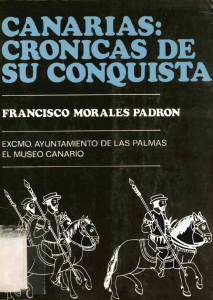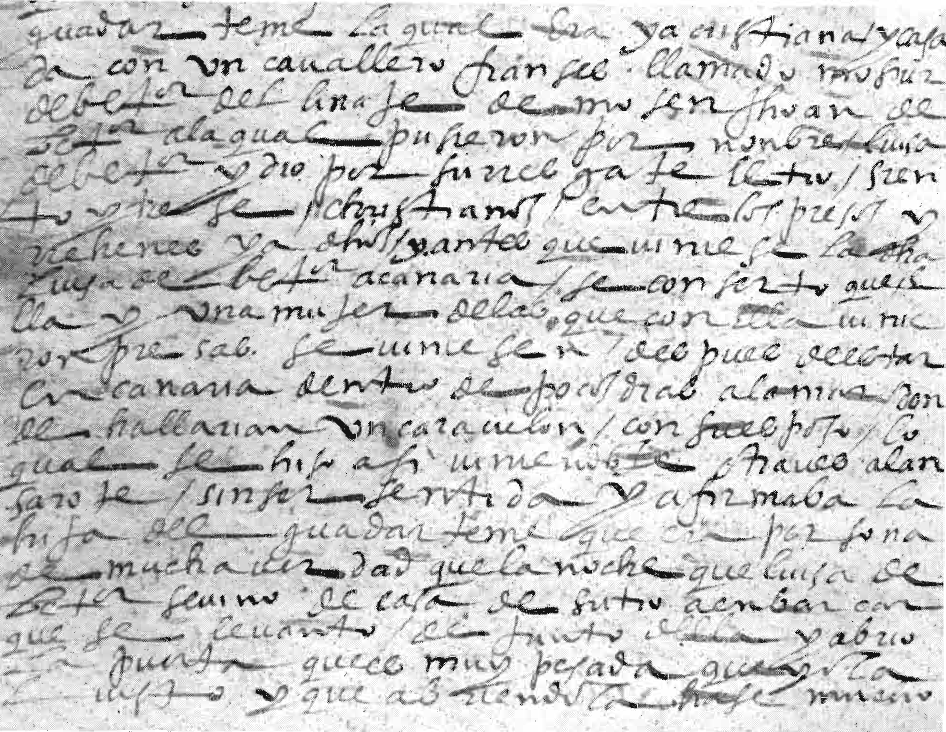
Cover of the 1978 edition of the work Canarias: Crónicas de su conquista, by Professor Francisco Morales Padrón —source: Memoria Digital de Canarias – Universidad de Las Palmas de Gran Canaria—.
As in the New World, the Chronicle is the story of a drama. Because it is the story of the dissappearance of a people. This people has not left us its account on the Conquest. We miss the other side. Who tells is the winner.
[…]
The contents of the Canarian chronicle are similar to those of the Indian’s and the events (relations among conquerors and indigenes, curiosity about the latter’s world, etc.) are a sort of preannouncement of the American affair.
Francisco Morales Padrón –Canarias: Crónicas de su conquista (1978), pp. 14, 54.– (this translation by PROYECTO TARHA)
This is a work that we consider to be a first and essential reading for anyone wishing to enter the knowledge of the ancient sources dealing with the conquest of the Archipelago. Canarias: Crónicas de su conquista – Transcripción, estudio y notas (The Canaries: Chronicles on their Conquest – Transcript, study and notes) is an annotated collection of key documents for the Canarian historiography, which was prepared by Professor Francisco Morales Padrón (Santa Brígida, Gran Canaria, 1923 – Sevilla, 2010), accompanied by an introductory study. Specifically, the collection includes the following Canarian chronicles:
- Cronica Ovetensis.
- Cronica Lacunensis.
- Cronica Matritensis.
- Antonio Sedeño’s account.
- Pedro Gómez Escudero’s account.
- Francisco López de Ulloa’s history.
But the work also includes an appendix with excerpts, transcribed by other professionals, taken from some European chronicles that mention the conquest of the Archipelago:
- An excerpt of Alonso de Palencia’s Fourth Decade.
- The 37th Chapter of Diego de Valera’s Chronicle of the Catholic Monarchs.
- An excerpt of the Memoirs of the Reign of the Catholic Monarchs, by Andrés Bernáldez, priest of Los Palacios.
By now, we will omit the last three documents and merely offer some notes on the Canarian chronicles instead.
Cronica Ovetensis, Lacunensis & Matritensis
The Chronicle surrenders to the Leader’s prestige; the common people, the pawns, it is not interested in. And that is because the Chronicle is written either by the Leader or for the Leader.
Francisco Morales Padrón –Canarias: Crónicas de su conquista (1978), p. 17.– (this translation by PROYECTO TARHA)
These three chronicles are later copies (17th Century) of a missing original document, commonly referred as the Mother Chronicle.[1]MORALES (1978), p. 82. Professor Manuel Lobo Cabrera is one of those experts trying nowadays to find out the fate of this important manuscript. Modern historiography gives them names corresponding to the cities –Oviedo, La Laguna and Madrid– where the respective manuscripts are kept. Their full titles are: [2]MORALES (1978), pp 107, 185, 229.
- CRONICA OVETENSIS (1639, Universidad de Oviedo Library, catalogue number M-164, beginning in folio 96r.):
- LIBRO DE LA CONQUISTA DE LA YSLA DE GRAN CANARIA Y DE LAS DEMAS YSLAS DELLA TRASLADADO DE OTRO LIBRO ORIJINAL DE LETRA DE MANO FECHO POR EL ALFERES ALONSO JAIMES DE SOTOMAYOR QUE UINO POR ALFERES MAYOR DE LA DICHA CONQUISTA EL QUAL SE HALLO EN ELLA DESDE EL PRINCIPIO HASTA QUE SE ACABO Y MURIO EN LA UILLA DE GALDAR EN CANARIA DONDE TIENE OY UISNIETOS, EL QUAL LIBRO ORIJINAL RREMITIO A ESTA YSLA EL CAPITAN JHOAN DE QUINTANA PERSONA FIDEDINA Y DE MUCHO CREDITO DONDE FUE TRASLADADO POR EL CAPITAN ALONSO DE XEREZ CARDONA EN QUATRO DE MARSO DE MIL Y SEISSIENTOS Y TREYNTA Y NUEUE AÑOS.
- BOOK ON THE CONQUEST OF THE ISLAND OF GRAN CANARIA AND THE OTHER ISLANDS OF IT COPIED FROM ANOTHER ORIGINAL BOOK HANDWRITTEN BY LIEUTENANT ALONSO JAIMES DE SOTOMAYOR WHO CAME AS STANDARD-BEARER OF THE AFORESAID CONQUEST WHO FOUND HIMSELF IN IT FROM THE BEGINNING UNTIL IT WAS FINISHED AND DIED IN GALDAR TOWN IN CANARIA WHERE HE HAS GREAT-GRANDCHILDREN AT PRESENT, BEEN THAT ORIGINAL BOOK SENT TO THIS ISLAND BY CAPTAIN JHOAN DE QUINTANA AN UPRIGHT AND MUCH REPUTABLE PERSON WHERE IT WAS COPIED BY CAPTAIN ALONSO DE XEREZ CARDONA THE FOURTH DAY OF MARCH OF ONE-THOUSAND AND SIX-HUNDRED AND THIRTY-NINE YEARS. (this translation by PROYECTO TARHA)
- CRONICA LACUNENSIS (17th century, Universidad de La Laguna Library, catalogue number Ms.42):
- CONQUISTA DE LA ISLA DE GRAN CANARIA HECHA POR MANDADO DE LOS SEÑORES REYES CATHOLICOS DON FERNANDO Y DOÑA ISABEL. POR EL CAPITAN DON JUAN REJON Y EL GOVERNADOR RODRIGO DE VERA CON EL ALFERES MAYOR ALONSO JAIMES DE SOTOMAYOR. COMENSOSE POR MUSIUT JOAN DE BETANCURT. EL AÑO DE 1439 Y SE ACAVO EL AÑO DE 1477 DIA DEL BIENAVENTURADO S. P.° MARTYR A 29 DE ABRIL Y DURO 38 AÑOS ESTA CONQUISTA.
- CONQUEST OF THE GRAND CANARY ISLAND MADE BY ORDER OF THE CATHOLIC MONARCHS LORD AND LADY DON FERNANDO AND DOÑA ISABEL. BY CAPTAIN DON JUAN REJON AND GOVERNOR RODRIGO DE VERA WITH STANDARD-BEARER ALONSO JAIMES DE SOTOMAYOR. IT WAS STARTED BY MUSIUT JOAN DE BETANCURT. YEAR 1439 AND IT WAS FINISHED YEAR 1477 THE DAY OF THE BLESSED ST. PETER MARTYR 29th APRIL AND LASTED 38 YEARS THIS CONQUEST. (this translation by PROYECTO TARHA)
- CRONICA MATRITENSIS (17th century, Biblioteca Nacional de España, catalogue number MSS/12933/17):
- CONQUISTA DE LAS SIETE ISLAS DE CANARIAS.
- CONQUEST OF THE SEVEN ISLANDS OF THE CANARIES. (this translation by PROYECTO TARHA)
The first title, belonging to the copy that is considered to be the oldest and most faithful to the original, says the author of the chronicle was Alonso Jáimez de Sotomayor, Standard-Bearer of the Royal Conquest of Gran Canaria, who was also brother-in-law and lieutenant of Captain Juan Rejón, first military leader of the campaign, and the pro-Rejonist mood of the three accounts supports that statement. If this alleged authorship turns out to be true, the Mother Chronicle should have been written between the end of the conquest of Gran Canaria (1483-1484) and the first two decades of the sixteenth century, because Jáimez de Sotomayor cannot be said, at present, to be alive after 1512. [3]MORALES (1978), p. 81-85. Other authors, as Professor Manuel Lobo Cabrera, attribute that authorship to Conqueror Pedro de Argüello..
A feature shared among these three copies is that they are neither identical with each other nor completely faithful to the original document, as the respective amanuenses –copyists– omitted, modified and / or interpolated data either of their own or from other sources of information. The chronology addressed in these documents spans from the beginning of the Lords’ Conquest until the establishment of the Hearing in Gran Canaria.

A fragment of the 1639 manuscript known as Cronica Ovetensis (source: MORALES (1978), p. 121).
The History by López de Ulloa and the accounts by Sedeño and Gómez Escudero
So obscure is the authorship of the three other documents transcribed by Professor Morales Padrón that some experts prefer to call them apocryphal, as barely exist more biographical data than those provided by the writers themselves in their respective works. First, the History written by Bachelor Francisco López de Ulloa is just another version of the Mother Chronicle, possibly made out of one of its copies. The interest of this document lies in providing additional data, among which is one of the oldest references to the supposed apparition of the Virgin of the Pine (Teror, Gran Canaria). [4]MORALES (1978), p. 44- 46.
- HISTORY OF THE CONQUEST OF THE SEVEN CANARY ISLANDS (1646, Biblioteca Nacional de España, catalogue number MSS/3218):
- HISTORIA DE LA CONQUISTA DE LAS SIETE YSLAS DE CANARIAS. RECOPILADA POR EL LICENCIADO DON FRANCISCO LÓPEZ DE ULLOA, NATURAL DELLAS. AÑO DE 1646.
- HISTORY OF THE CONQUEST OF THE SEVEN ISLANDS OF THE CANARIES. COMPILED BY BACHELOR DON FRANCISCO LÓPEZ DE ULLOA, BORN IN THEM. YEAR 1646. (this translation by PROYECTO TARHA)
Of the original manuscript of the so-called account by Antonio Sedeño –or Cedeño–, allegedly written between the 15th-16th centuries, only three copies made in the seventeenth century are preserved, two of which are kept in the archive of the County Estate of Vega Grande de Guadalupe (Gran Canaria) and the third by the hand of Grandcanarian historian Tomás Marín de Cubas, was in El Museo Canario collections along with other copies made between 18th-20th centuries:
- BREBE RESUMEN Y HISTORIA
NOMUY VERDADERA DE LA CONQUISTA DE CANARIA, SCRIPTANOPOR ANTONIO CEDEÑO, NATURAL DE TOLEDO, UNO DE LOS CONQUISTADORES QUE VINIERON CON EL GENERAL JUAN REXON (s. XVII, Archivo de El Museo Canario) - A BRIEF SUMMARY AND
NOTMUCH TRUE HISTORY OF THE CONQUEST OF CANARIA,NOTWRITTEN BY ANTONIO CEDEÑO, BORN IN TOLEDO, ONE OF THE CONQUERORS WHO CAME WITH GENERAL JUAN REXON (17th century, El Museo Canario Archive) (this translation by PROYECTO TARHA)
Was this or not his real name, as well as providing new data of various kinds, Antonio Sedeño raises an account antagonistic to that of the Mother Chronicle as to the merits of Captain Juan Rejón, and hence the copyist (Marín de Cubas) interpolated two NOT in the title, amended afterwards, with a possible intention to discredit the testimony of the alleged conqueror, a character of dubious existence on the other hand.[5]CEBRIÁN (2007), pp 118-119;.. MORALES (1978), pp . 89-91. As for the manuscript by Pedro Gómez Escudero or Pedro Hernández, it does suffer the same difficulties in its identification and original dating than Sedeño’s account, but it seems clear that it is a compilation work carried out by Marín de Cubas (his own handwriting is noticeable) from a number of authors, whose main significance lies in the considerable amount of ethnographic data provided. [6]Researcher José Antonio Cebrián Latasa claimed that this work was actually a pseudo-chronicle written by Marín de Cubas using a pseudonym. See CEBRIÁN (2007) p. 114.
- LIBRO SEGUNDO PROSIGUE LA CONQUISTA DE CANARIA. SACADO EN LIMPIO FIELMENTE DEL MANUSCRITO DEL LICENCIADO PEDRO GOMES SCUDERO, CAPELLÁN (s. XVII, Archivo de la Casa Condal de la Vega Grande de Guadalupe, Gran Canaria).
- SECOND BOOK RESUMING THE CONQUEST OF CANARIA. FAITHFULLY AND CLEANLY TAKEN FROM THE MANUSCRIPT BY BACHELOR PEDRO GOMES SCUDERO, CHAPLAIN (17th century, Archive of the County Estate of Vega Grande de Guadalupe, Gran Canaria)
Once again, we recommend reading this great compilation by Professor Morales Padrón; a work, as we say, essential to enter the drama of the Conquest of the Canary Islands.
Antonio M. López Alonso
References
[1] Cebrián Latasa, J. A. (2007). Apuntes para un catálogo de autores que han tratado sobre la historia de Canarias. Cartas diferentes. Revista canaria de patrimonio documental, 1(3):109–151. [2] Morales Padrón, F. (1978). Canarias: Crónicas de su conquista. Ayuntamiento de Las Palmas de Gran Canaria – El Museo Canario.
